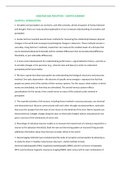SENSATION AND PERCEPTION – CHAPTER SUMMARY
CHAPTER 1: INTRODUCTION
1. Sensation and perception are central to, and often precede, almost all aspects of human behavior
and thought. There are many practical applications of our increased understanding of sensation and
perception.
2. Gustav Fechner invented several clever methods for measuring the relationship between physical
changes in the world and consequent psychological changes in observers. These methods remain in
use today. Using Fechner’s methods, researchers can measure the smallest levels of a stimulus that
can be detected (absolute threshold) and the smallest differences that can be detected (difference
thresholds, or just noticeable differences).
3. A more recent development for understanding performance—signal detection theory—permits us
to simulate changes in the perceiver (e.g., internal noise and biases) in order to understand
perceptual performance better.
4. We learn a great deal about perception by understanding the biological structures and processes
involved. One early observation—the doctrine of specific nerve energies—expresses the fact that
people are aware only of the activity of their nervous systems. For this reason, what matters is which
nerves are stimulated, not how they are stimulated. The central nervous system reflects
specializations for the senses, from cranial nerves to areas of the cerebral cortex involved in
perception.
5. The essential activities of all neurons, including those involved in sensory processes, are chemical
and electrochemical. Neurons communicate with each other through neurotransmitters, molecules
that cross the synapse from the axon of one neuron to the dendrite of the next. Nerve impulses are
electrochemical; voltages change along the axon as electrically charged sodium and potassium ions
pass in and out of the membranes of nerve cells.
6. Recordings of individual neurons enable us to measure the lowest level of a stimulus required for a
neuron to fire (absolute threshold). Both the rate and the timing pattern of neuronal firing provide
additional information about how the brain encodes stimuli in the world.
7. Neuroimaging methods have revolutionized the study of sensation and perception by allowing us
to study the brain in healthy, living human observers. Useful methods include
electroencephalography (EEG), magnetoencephalography (MEG), positron emission tomography
(PET), and functional magnetic resonance imaging (fMRI). Each comes with its own combination of
, temporal and spatial properties, making one method suitable for researching some questions and
other methods more suitable for other questions.
8. Computational models have become more useful than ever for revealing ways through which
sensation and perception develop through experience. What all of these models have in common is
that the world has predictability that can be exploited to make the senses more attuned to the
world.
9. Deep learning algorithms are powerful tools that can take in vast amounts of data (e.g. pictures)
and categorize it (That’s a cat.). Such tools may become important in applications like autonomous
driving or detecting cancer in medical images.
CHAPTER 2: THE FIRST STEPS IN VISION – FROM LIGHT TO NEURAL SIGNALS.
1. This chapter provided some insight into the complex journey light must take for us to see stars and
other spots of light. The path of the light was traced from a distant star through the eyeball and to its
absorption by photoreceptors and its transduction into neural signals. In subsequent chapters we’ll
learn how those signals are transmitted to the brain and translated into the experience of
perception.
2. Light, on its way to becoming a sensation (a visual sensation, that is), can be absorbed, scattered,
reflected, transmitted, or refracted. It can become a sensation only when it’s absorbed by a
photoreceptor in the retina.
3. Vision begins in the retina, when light is absorbed by rods or cones. The retina is like a
minicomputer that transduces light energy into neural energy.
4. The high degree of convergence in the retinal periphery ensures high sensitivity to light but poor
acuity.
5. The low degree of convergence in the fovea ensures high acuity but poor sensitivity to light.
6. The one-to-one pathways between cones and ganglions exist only in the fovea and account for
why images are seen most clearly when they fall on this part of the retina.
7. The visual system deals with large variations in overall light intensity by (a) regulating the amount
of light entering the eyeball, (b) using different types of photoreceptors in different situations, and (c)
effectively throwing away photons we don’t need.






